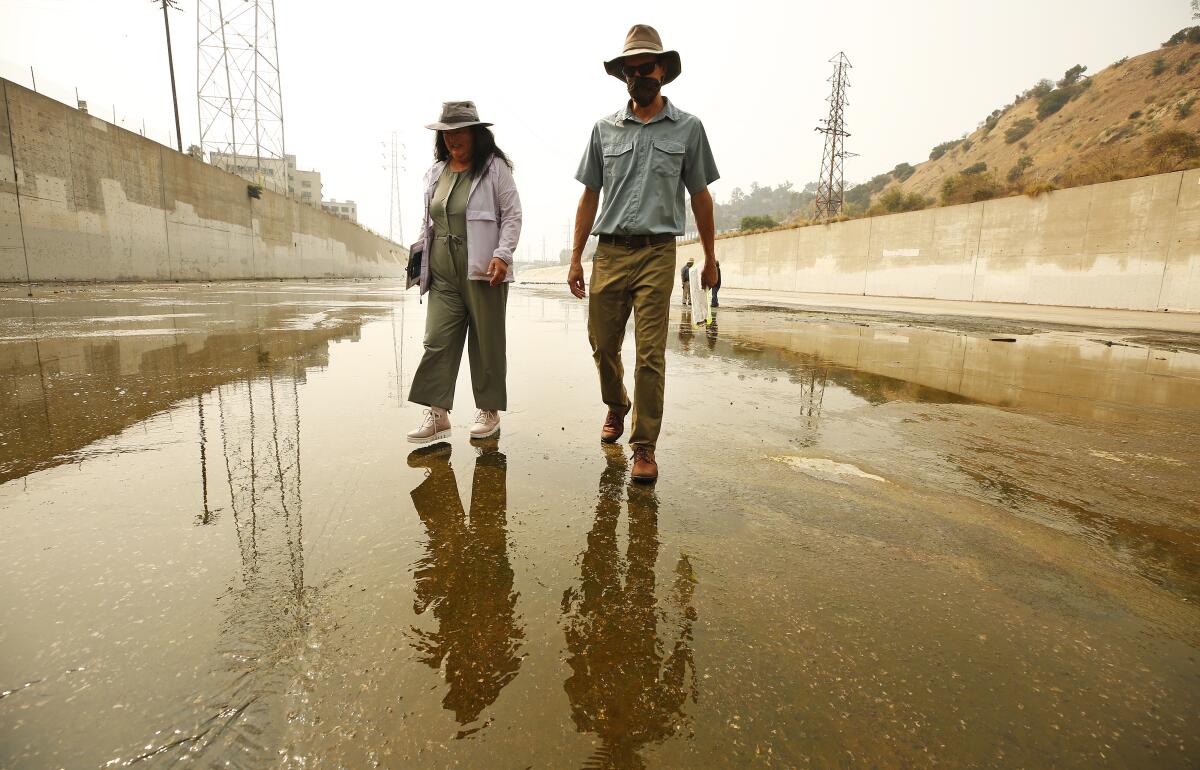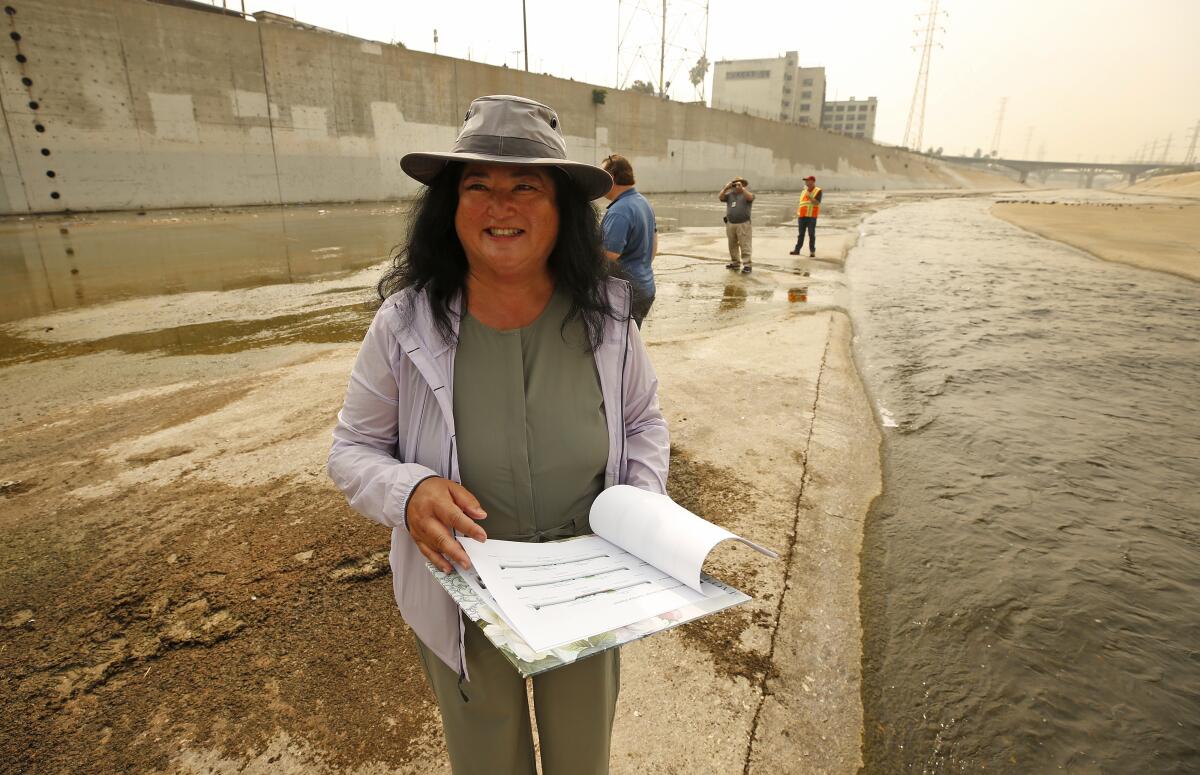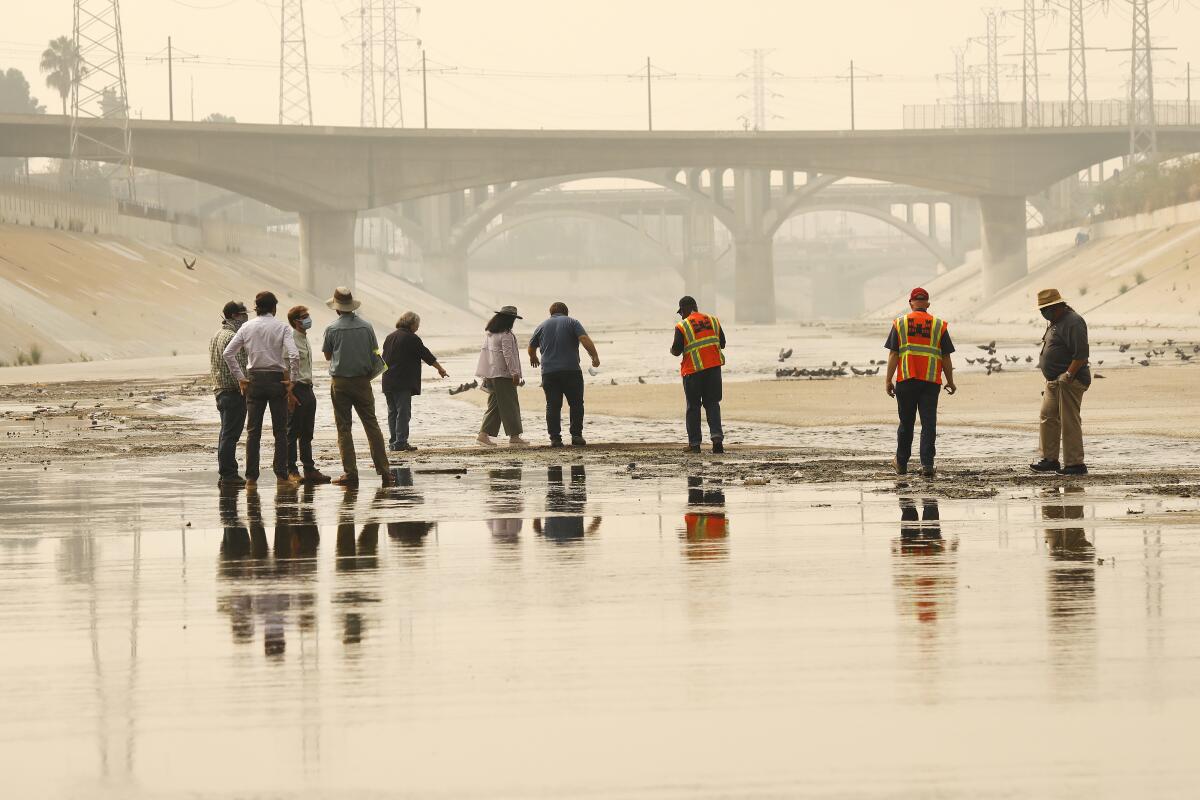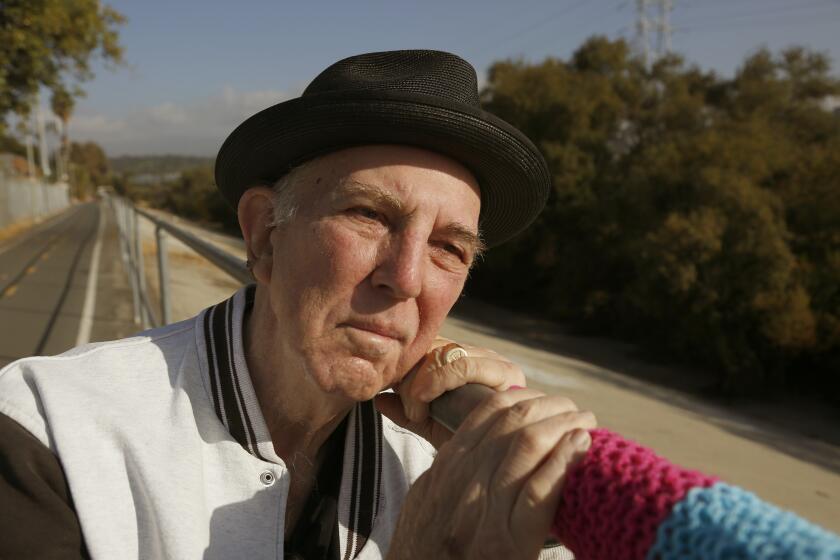Steelhead trout in the L.A. River? These experts envision a fish passage through downtown

Biologists and engineers are setting the stage for an environmental recovery effort in downtown Los Angeles that could rival the return of the gray wolf, bald eagle and California condor.
This time, the species teetering on the edge of extinction is the Southern California steelhead trout and the abused habitat is a 4.8-mile-long stretch of the L.A. River flood-control channel that most people only glimpse from a freeway.
The brutal vista of concrete and treated urban runoff exists as an impenetrable barrier to ancestral spawning grounds in the San Gabriel Mountains for the estimated 400 federally endangered Southern California steelhead left on Earth.
The Los Angeles River Fish Passage and Habitat Structures Design Plan, which is being championed by Mayor Eric Garcetti, aims to change all that with a carefully calibrated retrofit.
On a hot and hazy morning recently, scientist Wendy Katagi gazed across a sheet of murky water strewn with trash and slick with algae near the confluence of the river and the Arroyo Seco. “We’re going to turn this place into a trout stream again,” she said.

“We’re going to roughen the bottom with pebbles and deepen the notch along the center of the channel by at least 2 feet,” said Katagi, a senior manager at Stillwater Sciences, a consulting firm specializing in restoring rivers and flood plains. “Some areas will be terraced, and boulders up to 5 feet in diameter will be anchored to create pools where steelhead can rest and bulk up during their migratory journeys.”
In one of nature’s most theatrical displays, southern steelhead, a species of salmon that grows up to 36 inches in length and 8 pounds, mature in the Pacific Ocean and return to local rivers to spawn again.
Unlike salmon, which stop eating and die after spawning in their specific natal streams and rivers, steelhead can spawn multiple times in various streams throughout their region.
The modifications, combined with floodwaters in winter, would provide safe passage through downtown for steelhead that began their migratory journey in the brackish, mile-long soft-bottom mouth of the river in Long Beach, 20 miles to the south.
The fish passage, designers say, will serve as a pilot for similar efforts along the roughly 50-mile channel, as well as the L.A. River watershed, which drains 834 square miles of land bounded by the San Gabriel, Santa Monica and Santa Susana mountain ranges.
The flood-control channel is operated by the U.S. Army Corps of Engineers and L.A. County Public Works engineers. Biologists and city officials hope to see the project completed before the start of the 2028 Summer Olympics in Los Angeles.
A local poet and lifelong environmental activist, MacAdams dedicated his life to restoring the Los Angeles River.
In an interview, Garcetti said: “It has been a long time coming, but we’re going to welcome steelhead back home. Doing that will mean a restoration of nature literally down the very spine of this great city.”
The velocity of the water remains the crux of the problem — for fish and for humans. The measure of safety provided by the non-erodible flood-control channel is a cornerstone of the region’s economy.

“The L.A. River channel was designed exclusively to flush water to the ocean as quickly as possible and keep people dry,” said Nathan Holste, a hydraulic engineer with the U.S. Bureau of Reclamation.
It can contain a discharge of about 104,000 cubic feet per second during a 100-year flood event.
“Trouble is, even flows of 5 feet per second are above the cruising speed of steelhead trout,” he said. “So, our goals include controlling the flows and offering plenty of places for fish to rest.
“Steelhead swim upstream at an average speed of about 7 miles per day,” he added. “We believe that steelhead will be able to reach the passage in about three days — then swim through it without scraping their bellies on concrete.”
Re-creating self-sustaining native plant communities will need to take the physical peculiarities of the channel into account. For example, south of 1st Street, the east bank provides slightly more shade than the west bank because the channel there runs slightly southeast.
In the meantime, there are myriad permitting hurdles to clear before altering the crucial flood-control system to assist steelhead without affecting adjacent freeway overpasses, historic bridges and levees, utility and fuel lines, and railroad tracks and trestles.
That is, if there’s a will — and money.
Design phases of the project are being funded by the California Wildlife Conservation Board under a Proposition 68 grant of $1.3 million. The city of Los Angeles, the nonprofits Council for Watershed Health, Friends of the Los Angeles River and Arroyo Seco Foundation, and other partners are providing in-kind services as matching funds.
The estimated cost of the fish passage project has yet to be determined, but its designers say it will be in the tens of millions.
The project would complement river restoration efforts proposed or underway throughout the L.A. River watershed.
They include a long-awaited river revitalization project north of downtown approved by the Army Corps of Engineers. That project is still in the planning stages and estimated to cost $1.3 billion. Lower L.A. River projects are proposed in Bell, Cudahy, Downey, Long Beach and other communities.
So why the focus on steelhead now?
The Endangered Species Act requires the government to take action to prevent extinction of species listed as endangered. The Southern California steelhead was listed as federally endangered in 1997.
Steelhead, which begin life as native rainbow trout, once packed local spawning pools. For still unknown reasons, some migrate to the ocean and become steelhead after undergoing physical changes that allow them to return to spawn in freshwater gravel beds.
But the explosive growth of Los Angeles after the turn of the last century, followed by catastrophic flooding in 1914 and 1938, prompted civic leaders to transform the river channel into a concrete floodwater channel to protect the burgeoning flatlands.
Much of the work began in 1938, a reclamation job of mammoth proportions designed to manage the river’s rambunctious hydrology. It included construction of check and debris dams to stabilize creeks flowing from the San Gabriel Mountains, and flood-control and storage basins such as the Hansen and Sepulveda dams.
Today, the L.A. River is managed by one of the most extensive systems of controls for any river its size in the world. Nearly the entire river bottom was paved over, except a few spots where the water table was too high.
But the engineering feats that straightened the river and keep it in place affected steelhead in a fundamental fashion. River flows of treated urban runoff were too shallow, rapid and devoid of vegetation and pools in which to rest during crucial periods when the fish shifts from fresh water to salt, or vice versa.
Scientists say the southern steelhead population has plummeted from an estimated 36,000 to 46,000 adults to fewer than 400 scattered across coastal waters between San Luis Obispo and the Mexican border.
The last one seen in the L.A. River was caught off a Glendale bridge in 1940 after that stretch of the river was paved for flood control.
The fish that scientists know as Oncorhynchus mykiss — a distant cousin of salmon — still shows up in small numbers in places such as Ballona Creek, Malibu Creek, San Juan and Trabuco creeks, and three Ventura County rivers, scientists say.
But even some optimists wonder: If the fish passage is built, will steelhead come?
Holste, the federal hydraulic engineer, doubts that steelhead would be able to reach the passage without similar modifications installed along the other 16 miles of channel between it and the sea.
But Mary Larson, coordinator of steelhead recovery at the California Department of Fish and Wildlife, believes that under certain conditions, “steelhead will use it.” Construction of additional projects later would improve its viability, she said.
“After years of studying their behavior, I can tell you that these fish are extraordinarily resilient and do things we wouldn’t think possible,” Larson said. “For instance, they can sense the precise path of least resistance to spawning grounds needed to continue their genetic lineage.”
Rosi Dagit, a senior biologist for the Resource Conservation District of the Santa Monica Mountains, agreed. “Building this fish passage would be a historic step toward saving steelhead,” she said, “and helping every other native aquatic species that no longer feels at home in the L.A. River.”
Among them are rare species that take refuge in remote sections of the watershed such as the Santa Ana sucker, arroyo chub, unarmored three-spine stickleback, speckled dace, red-legged frog, southwestern pond turtle and arroyo toad.
Many cities around the world have revitalized rivers that had suffered from a disconnect between communities and their waterways.
In South Korea, the Cheonggyecheon, which was covered for years, now meanders through the capital city of Seoul. The San Antonio River Walk is a popular network of city parks and walkways edging the San Antonio River one story beneath the streets of San Antonio. The San Diego River Park Foundation recovery effort was launched by concerned citizens in 2000 after the largest sewage spill in California’s history dumped 34 million gallons of untreated sewage into the 49-mile-long waterway.
“If all goes smoothly,” said Michael Affeldt, LARiverWorks director in the mayor’s office, “the fish passage project will put some natural heart and soul back into the L.A. River, too.”
The Council for Watershed Health has launched a webpage allowing people to keep up with the progress of the fish passage project and learn more about the ecological problems it aims to solve, said Andrea Dell’Apa, project manager at the council.
Awareness of the river as a natural resource and potential economic powerhouse began to grow in the 1980s when environmental groups pressured the county and Army Corps of Engineers. Ever since then, the waterway has been slowly transforming into a greenbelt of parks, trees and bike paths linking new development including apartments and breweries.
In 2010, the U.S. Environmental Protection Agency deemed the river navigable and subject to the protections of the Clean Water Act. A year later, the U.S. Army Corps of Engineers permitted kayaking along a soft-bottom stretch about 17 miles north of downtown.
The river has always been a catalyst for change that helped transform the sleepy village of Los Angeles into a metropolis of about 4 million people.
The first settlers who arrived here in 1781 put down their roots along the Los Angeles River precisely because of the water that was available there. The principal source was the river’s “narrows,” a spot below the bluffs where the 110 Freeway now crosses the concrete channel near Elysian Park.
There, near where the concrete ends north of downtown and the 11-mile soft-bottom portion begins, you can hear the rustle of leaves again.
The cackle of ducks and warble of migrating birds blend with the din of railroads and freeway traffic and echo off the channel’s slanted concrete walls.
Cottonwood saplings, sycamore trees and weeds sprout from the edges of the river’s perennial cargo of warm, green treated runoff that carries the odor of old socks. Beneath the ripples, a steady parade of leeches, algae, silt and trash floats downstream.
The return of spawning steelhead populations in the area would trigger one of the most unlikely sport-fishing opportunities in modern history.
But angling for steelhead would be out of the question until there are enough of them to warrant the lifting of their endangered species protections.
For now, there are more pressing concerns.
“We have to be successful with the steelhead recovery effort,” said Sandra Jacobson, director of the southwest region for the nonprofit California Trout, “before it goes extinct.”








